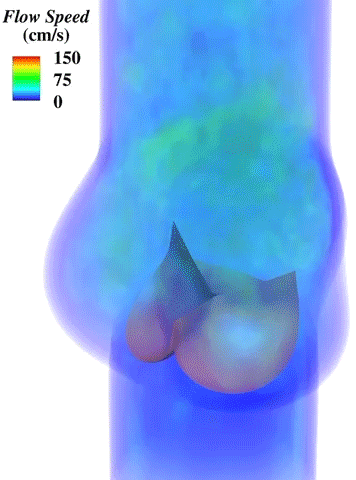 Artificial heart valves have been used for quite some time with percutaneous devices becoming common in the last few years. While very successful in a large number of patients, the valves still suffer from a number of limitations that can lead to health issues for patients. Researchers at the Institute for Computational Engineering and Sciences (ICES) at The University of Texas at Austin have been using machines at the Texas Advanced Computing Center (TACC) to simulate natural and artificial valves and how blood flows through them. The research is aimed at helping to engineer new artificial valves and to develop tools for repair of natural ones.
Artificial heart valves have been used for quite some time with percutaneous devices becoming common in the last few years. While very successful in a large number of patients, the valves still suffer from a number of limitations that can lead to health issues for patients. Researchers at the Institute for Computational Engineering and Sciences (ICES) at The University of Texas at Austin have been using machines at the Texas Advanced Computing Center (TACC) to simulate natural and artificial valves and how blood flows through them. The research is aimed at helping to engineer new artificial valves and to develop tools for repair of natural ones.
The team has been modeling the natural mitral valve on the cellular level, studying how tissue stretching affects cells within different areas of the valve. They stretched actual valve tissue under a microscope and measured various parameters, using the results in the simulation. The findings were then integrated into a larger simulation of the entire valve, including the flapping of the leaflets, how they come together, and the hemodynamics around the valve. Because the simulation was done at the cellular level, the simulation required millions of CPU hours on three supercomputers at TACC.
 The researchers hope that their work will lead to personalized simulations of potential repairs and implantations, helping doctors identify which technique will result in prolonged positive outcomes for each individual patient.
The researchers hope that their work will lead to personalized simulations of potential repairs and implantations, helping doctors identify which technique will result in prolonged positive outcomes for each individual patient.
Here’s a discussion of the research with Michael Sacks, Simulation-Based Engineering Science Chair, Institute for Computational Engineering and Sciences, The University of Texas at Austin:
Source: TEXAS ADVANCED COMPUTING CENTER…
The post Supercomputers Analyze Valve Hemodynamics appeared first on Medgadget.
